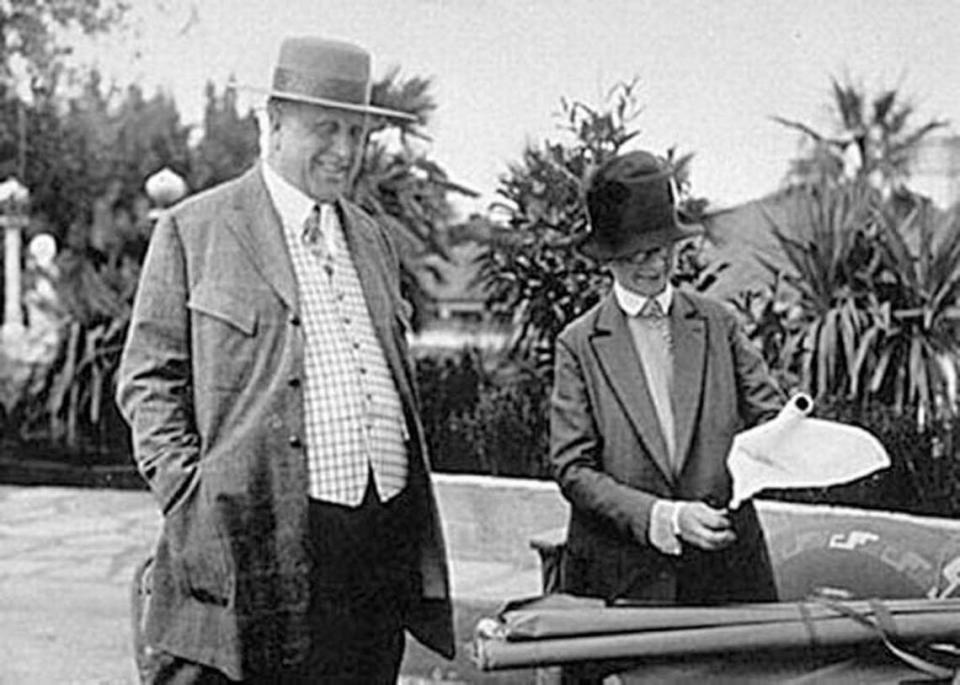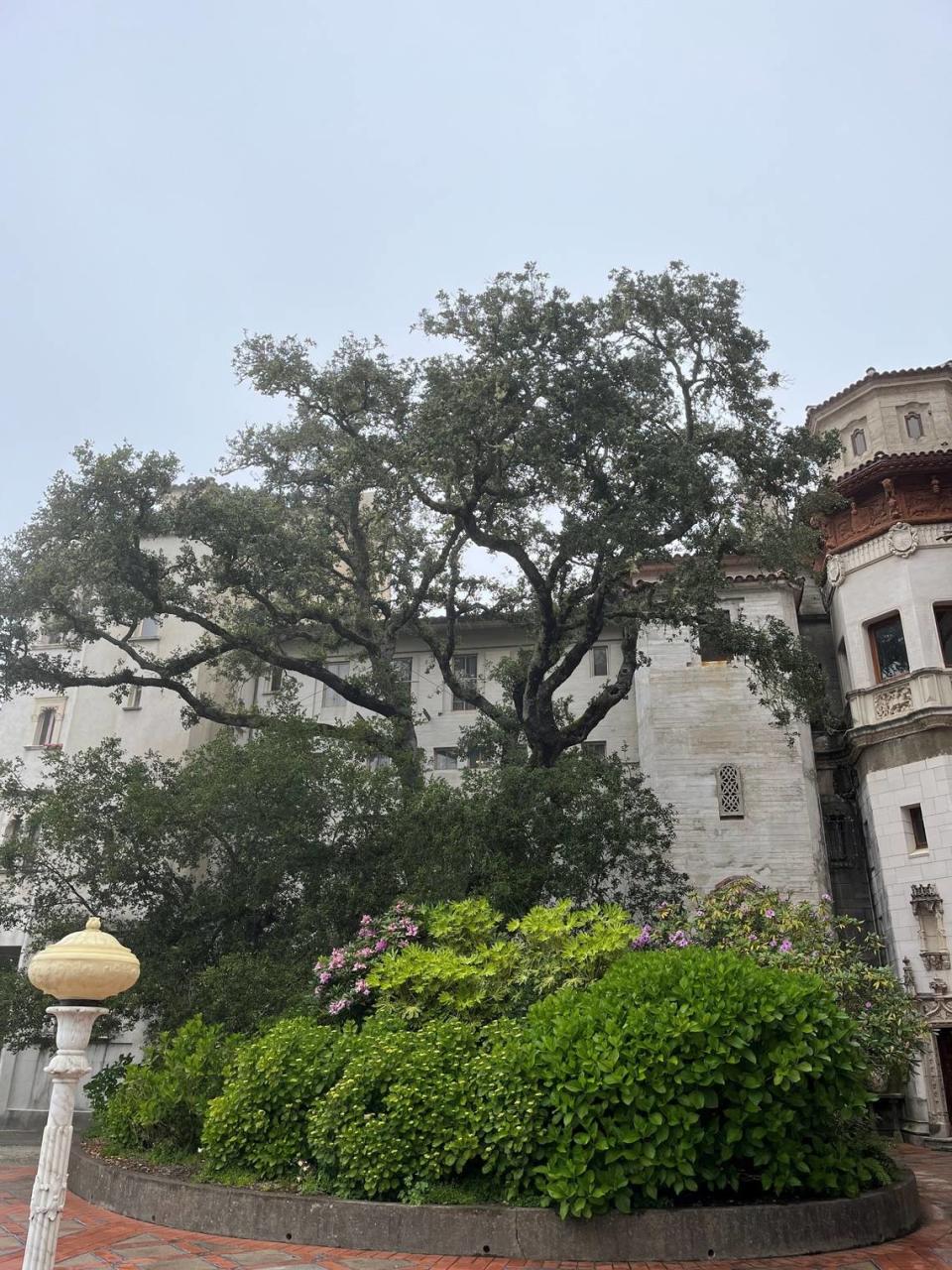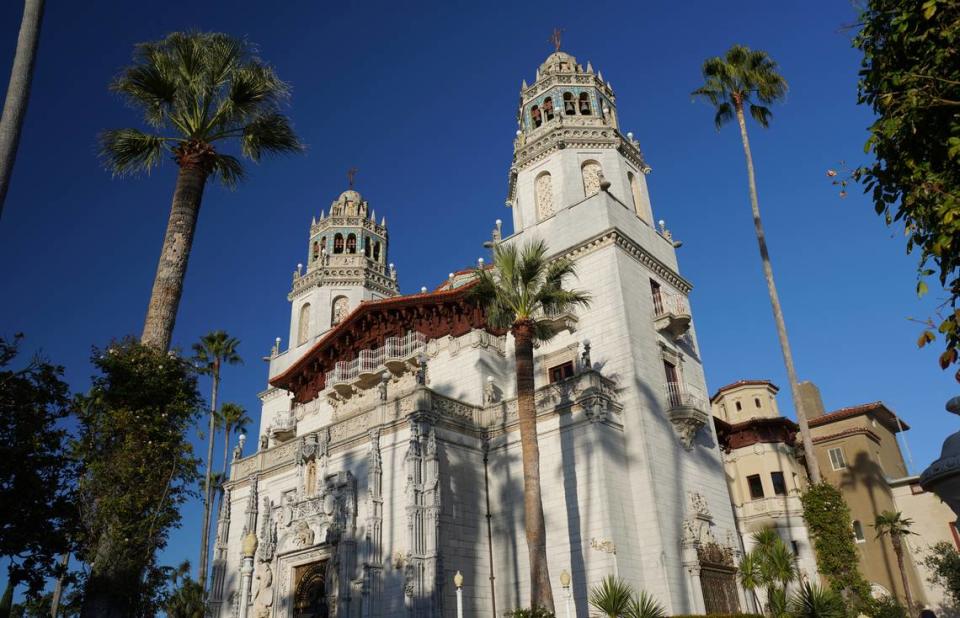Hearst Castle was built around this stately oak tree. Here’s why it’s coming down
- Oops!Something went wrong.Please try again later.
A stately piece of history is coming down at Hearst Castle on Tuesday, when a crew will begin cutting down a massive oak tree that stood on the property long before media mogul William Randolph Hearst built his sprawling estate on the hillside overlooking San Simeon.
According to the museum’s hefty historical records, the approximately 50-foot tall Quercus agrifolia tree — identified in plans as Coast Live Oak No. 7 — was growing there well before construction began on the compound in 1919. In fact, it was reportedly there when Hearst and his family camped on the ranch hilltop in the early 1900s (then dubbed “Camp Hill”), Museum Director Cara O’Brien told The Tribune on Friday.
According to the earliest design plans for the Castle, “that oak looked to be a pretty big tree then,” O’Brien said.
But for nearly a century, the sweeping, stately oak has battled the disease that now has doomed it to removal and replacement.
In 1930, Castle architect Julia Morgan wrote to Hearst, saying “the oak trees on the tea terrace have been stricken ... with a fungus root growth.”

“This oak root-rot disease is a common California one, and the extra watering needed for pansies, etc., have been favorable for its development,” she said. “I have asked Mr. Webb not to replant around the oaks until just before you return so as to give these oaks time to recuperate under more natural condition.”
Hearst’s love of the hilltop’s oaks is well documented. During construction of the estate, he hired house movers to relocate some of the hilltop’s biggest oaks instead of cutting them down to make room for construction. It was a massive undertaking.
Later, to help sustain the infected oaks, Hearst’s crews placed cement inside their trunks, O’Brien said. The odd-sounding treatment apparently had been successful for decades.
Recently, Castle experts and independent master arborist Rodney Thurman concluded that, after decades of groundskeepers and others having babied it along, the tree now poses a danger to the public, State Parks staff, the main building and some of the museum’s priceless collection, said O’Brien and Dan Falat, the superintendent of State Parks’ San Luis Obispo Coast District.
“We have to get it out before someone gets hurt, which is especially likely during high winds and stronger storms,” Falat said.

Oak tree removal likely won’t be noticed by visitors, superintendent says
Falat estimated it would cost about $20,000 to remove the old oak and replace it with a new, smaller one.
The process won’t have major impacts to Castle tours, Falat said, only requiring some temporary rerouting of the exit path from the Designing the Dream and Cottages & Kitchen tours into the North Courtyard and the rest of the Castle grounds.
While the oak that’s being removed is unquestionably historic, it isn’t really a focal point on any tour, Falat said.
“There’s a big planter there with a lot of stuff around the oak, such as the hydrangeas,” he said. “You don’t really see the tree itself.”
Falat said the Castle’s collections crew and historic restoration staff were “taking the necessary precautions to protect things around the oak” during the work, such as creating boxes to shield some of the pieces.
Other plants will stay in place, he said.
Once the tree is taken out and replaced, even people familiar with that portion of the grounds “might only notice that’s something’s different, but they don’t quite know what,” Falat said, likening it to “moving a chair to a different part of a room.”

How they’ll do it
The job won’t be an easy one, with extra steps being taken to protect the things and people around it.
“Bunyan Brothers Tree Service will take the tree down to about 8 feet tall,” Falat said. “From the top down, they’ll cut the branches into small pieces and then zipline them to the ground. They’re using a kinder, gentler approach, getting in as close as they can.”
He estimated that would take three or four days.
“It’s really pretty slick,” O’Brien said.
The Castle’s “grounds crew will take over then, removing the remainder of the trunk and the roots,” Falat said, estimating that could take another six weeks or more.
Eventually, they’ll bring in “as large a tree as we can” to replace the historic oak, Falat said.
All the work being done is consistent with the Castle’s four-volume, nearly 1,000-page Landscape Preservation Maintenance Plan for the Castle, created by the Olmstead Center for Landscape Preservation, O’Brien said.
“It’s a living landscape that we try to maintain,” she said. “We did everything we could from 1995 on to save the tree.”
According to Murray Alcosser’s “America in Bloom: Great American Gardens Open to the Public,” Hearst brought in “over 100,000 trees, an eclectic mix” that included palms, cypress, giant oaks, eucalyptus, cedar of Lebanon and redwood, and then transported to picturesque sites on the landscape.
That the old oak has lasted as long as it has is “a real testament to the preservation done by the folks here in the last 75 years,” Falat said.
“That’s been the goal and the real work — being able to bring it along and maintain it for as long as we have,” he said. “Ultimately, trees and shrubs will eventually die. It’s part of the life cycle, the beauty and wonder of nature. Our job is to honor that while keeping things as close as possible to how they were when Mr. Hearst was here.”


